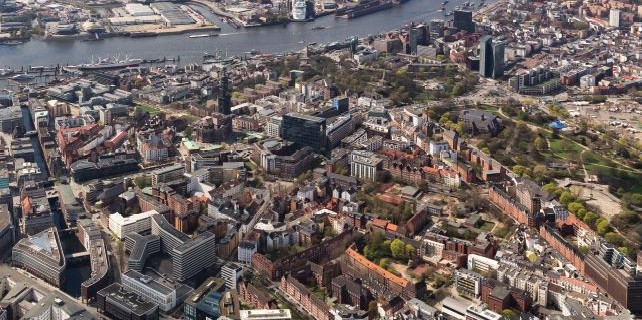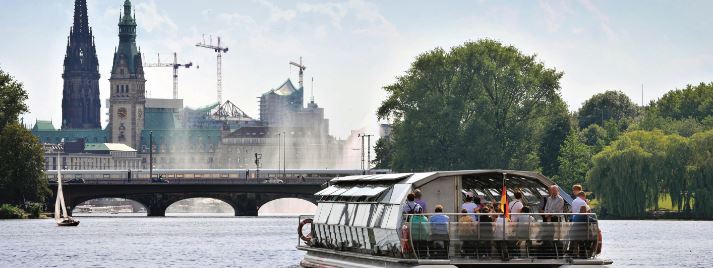Hamburg – A European Green Capital
Hamburg is Germany’s second-largest city (and a federal state in its own right) with 1.8 million inhabitants (5 million in the Greater Hamburg Metropolitan Region). According to Eurostat data, its GDP of roughly 50,000 € per capita makes it the third-wealthiest region in the European Union (after Inner London and Luxembourg). The city’s prosperity has been based traditionally on strong manufacturing industries and its port (the port of Hamburg continues to be Europe’s second largest after Rotterdam). While maintaining its industrial base, Hamburg today also has a strong service sector, especially logistics, transport and ancillary services, commerce, ICT, media and tourism. In recent years, Hamburg has become a prime location for inward FDI from China[1].

Photo: Andreas Vallbracht
Hamburg’s urban policies have long been largely consensual and environmentally friendly. In 2011, Hamburg became the European Green Capital, a title awarded annually by the European Commission for European leadership in environmental governance[2]. The title committed Hamburg to ‘sharing its experiences and best practices and serving as a role model to inspire other cities within the field of sustainable urban development’[3]. The Siemens Green City Index 2014[4], based on comprehensive data gathered by the Economist Intelligence Unit in over 120 cities worldwide, ranks Hamburg as exemplary and well above average in most assessment categories.
During its ‘European Green Capital’ phase, Hamburg has excelled in two major areas:
- Ecologically oriented inner city re-development (e.g. HafenCity and IBA International Building Exhibition)
- The very close relationship between industry and environment (e.g. its ‘Eco Partnership” and ‘Companies for Resource Protection’ schemes). Hamburg successfully turned environmental protection into a tool for further economic growth.
Of particular significance was also the targeting of the local population in a broad range of PSI (public sector information) activities, resulting in widespread public consensus about urban environmental policies and civic pride of being at the forefront of the European drive for sustainability. Particular emphasis was given to educational initiatives (HLN = Hamburg is Learning Sustainability / Hamburg lernt Nachhaltigkeit)[5].
The European Green Capital award in particular had long-lasting impact on urban development[6]. Among the achievements have been
- Public acceptance of climate protection and sustainability measures;
- Long-lasting ‘eco partnerships’ between the private and public sectors of the economy;
- Expansion of a safe and environmentally friendly energy supply mix (with a steadily growing proportion of renewables, especially wind power and solar energy), which is particularly significant in light of the German national ‘energy turnaround’ policies after the nuclear disaster at Fukushima;
- Increased energy-efficiency by modernizing (‘re-furbishing’) existing housing stock and building new homes, in cooperation with industry and tenant associations; introduction of ‘Energy Passports’ for homes; set-up of a municipal ‘energy agency’ (Hamburger EnergieAgentur) to assist private households and businesses to reduce energy consumption;
- The formation of the Hamburg Renewable Energy Cluster, aimed at making the city into a globally significant center for environmental technology (research, production, planning and services);
- Air quality improvement by expanding green space (nature reserves) and inner-city tree planting campaigns (My Tree – My City);
- Significant expansion of public transport facilities, employing technologies and ICT for greenhouse gas and pollutants reduction;
- Systematic expansion of alternative transport modes and means, e.g. cycling (preference over cars, city-wide bike rental system StadtRÄDER), ‘eco-taxis’ and using the city as one of several e-mobility test regions in Germany;
- Leading role in joint European city networks such as EUCO2-80/50, Eurocities, Natura 2000 and others, and international ‘brand recognition’ for Hamburg as a future-oriented, economically successful ‘green metropolis’ with a very high quality of living.
Between 2006 and 2013, the city also hosted the International Building Exhibition (Internationale Bauausstellung) IBA[7], complemented by the International Garden Show (Internationale Gartenausstellung Hamburg) IGS[8]. As of 2014, the IBA Hamburg GmbH has become a municipal project developer in charge with re-developing and marketing large swathes of urban space south of the city centre (the ‘Leap across the Elbe River’), while maintaining core principles of sustainability and participatory processes. The aim of the combined projects has been to transform former ‘problem districts’ (Wilhelmsburg, Veddel) into ‘quality neighborhoods’.

@www.mediaserver.hamburg.de/ Christian Spahrbier
IBA projects have been developed along three major thematic lines:
Cosmopolis emphasizes the city’s growing ethnic and cultural diversity as a source of urban strength and future growth. A cluster of sub-projects under the name of ‘Kreatives Quartier Elbinsel’ (Elbe Islands Creative Quarter) is seeking to integrate art, culture, and the creative industries into overall urban development measures. Cosmopolis also emphasizes access to education as a major integration tool.
Metrozones aims at the revitalization of ‘inner urban peripheries’, with a deliberate mix of housing and commercial (office) space so as to enhance city energy efficiency.
‘Cities and Climate Change’ refers to the construction of energy self-sufficient buildings and de-centralized energy production with the ultimate goal of creating ‘energy-neutral’ urban districts.
A second major urban development project is the Hamburg HafenCity, which will double the inner-city area in the years to come[12]. HafenCity has a broad range of architecturally and environmentally significant projects relating to all UI categories and of high relevance to Hong Kong, not the least to planning for the new CBD 2 in Kowloon East.
As of March 2015, Hamburg has become the official German candidate city for the 2024 Olympic Games[13]. Major events will take place on the Elbe Islands, connecting the prime IBA areas with the downtown center[14]. Construction and urban development measures will be a continuation of sustainability planning as put forward in the ‘European Green Capital’ scheme of the European Union. There are also master plans to extend urban revitalization projects to large areas east of the current core urbanization zones (‘Stromaufwärts an Elbe und Bille’)[15].
Based on the background information above, the primary interest of Urban Innovations lies in the overall theme 2 (Green City), with themes 1 (Smart City) and 4 (Culture and Creativity) to be included whenever feasible.
[1] http://www.gtai.de/GTAI/Navigation/EN/Invest/Service/Publications/markets-germany,did=1109474.html
[2] http://ec.europa.eu/environment/europeangreencapital/index_en.htm .
“One of the policy tools the European Commission is using […] the European Green Capital Award (EGCA), which recognizes and rewards local efforts to improve the environment, the economy and the quality of life in cities. The EGCA is given each year to a city, which is leading the way in environmentally friendly urban living and which can thus act as a role-model to inspire other cities.” (http://ec.europa.eu/environment/europeangreencapital/about-the-award/policy-guidance/index.html)
[3] http://ec.europa.eu/environment/europeangreencapital/green-buildings-hamburg/
[4] http://www.siemens.com/entry/cc/en/greencityindex.htm
[5] http://www.hamburg.de/nachhaltigkeitlernen/; impact study 2014: http://www.hamburg.de/contentblob/4313056/data/bericht-zur-arbeit-der-initiative-hln-2005-2014.pdf ; see also http://www.bne-portal.de/
[6] cf. Final Report 2012 http://ec.europa.eu/environment/europeangreencapital/wp-content/uploads/2011/04/Doku-Umwelthauptstadt-engl-web.pdf ; see also http://www.siemens.com/entry/cc/en/greencityindex.htm
[7] http://www.iba-hamburg.de/; overview of concept and projects: http://www.iba-hamburg.de/en/story/iba-hamburg.html
[8] http://www.hamburg.de/igs-2013/
[9] http://www.iba-hamburg.de/en/story/themes-of-the-iba/cosmopolis.html
[10] http://www.iba-hamburg.de/en/story/themes-of-the-iba/metrozones.html
[11] http://www.iba-hamburg.de/en/story/themes-of-the-iba/cities-and-climate-change.html
[12] http://www.hafencity.com/en/home.html
[13] cf. http://www.dw.de/hamburg-put-forward-as-candidate-city-for-2024-olympics/a-18319560 ;
http://www.euronews.com/2015/03/17/hamburg-chosen-as-german-bid-city-for-2024-olympics/
[14] Hamburg city portal http://www.hamburg.de/spiele-fuer-hamburg/; planned ‘sustainable’ facilities: http://www.hamburg.de/contentblob/4420632/data/anlagen-gesamtpaket.pdf
[15] http://www.hamburg.de/stromaufwaerts/
Event Calendar of the City
| << | Oct 2015 | >> | ||||
| Sun | Mon | Tue | Wed | Thu | Fri | Sat |
| 27 | 28 | 29 | 30 | 1 | 2 | 3 |
| 4 | 5 | 6 | 7 | 8 | 9 | 10 |
| 11 | 12 | 13 | 14 | 15 | 16 | 17 |
| 18 | 19 | 20 | 21 | 22 | 23 | 24 |
| 25 | 26 | 27 | 28 | 29 | 30 | 31 |
